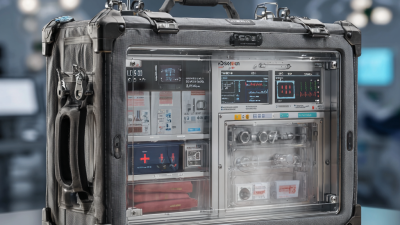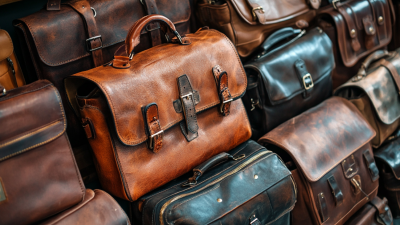- 0086-0769-87986375
- Welcome you to Dongguan Yili Bags Co., Ltd. website!
5 Essential Tips for Choosing the Best Medical Equipment Bag for Your Needs
In the ever-evolving landscape of healthcare, the significance of choosing the right Medical Equipment Bag cannot be understated. According to a recent survey conducted by the Healthcare Equipment Manufacturers Association (HEMA), nearly 70% of healthcare professionals reported that having a well-organized and durable bag significantly enhances their efficiency during patient care. These bags are not merely carriers; they are essential tools that ensure easy access to critical medical supplies and equipment. As hospitals and clinics strive for improved patient outcomes, the right Medical Equipment Bag emerges as a vital component in the daily operations of healthcare providers. With various options available in the market, it's crucial to consider key factors that cater specifically to individual needs, ensuring that medical professionals are always prepared and equipped for any situation.

Importance of Durability in Medical Equipment Bags for Long-term Use
When selecting a medical equipment bag, durability reigns supreme. With the healthcare landscape constantly evolving, professionals need bags that not only accommodate essential tools but also withstand the rigors of daily use. According to a report by the Journal of Healthcare Engineering, 35% of healthcare workers report issues with their equipment bags' material quality after a year of use. This statistic underscores the importance of investing in high-quality, durable materials like waterproof nylon or reinforced polyester that can endure wear and tear over time.
Tip 1: Look for bags with reinforced seams and sturdy zippers to prevent common points of failure. Features such as extra padding and heavy-duty straps can also contribute to the bag’s robustness, ensuring that it can bear the weight of multiple tools without falling apart.
Furthermore, longevity is not just about the materials used; it’s also about smart design. A survey by HCP Live revealed that 70% of medical professionals prioritize functional aspects that enhance ease of use during emergencies. This means that a durable bag should also have practical organization features, such as multiple compartments and easy-access pockets, making it easier for healthcare workers to quickly find what they need in high-pressure situations.
Tip 2: Choose bags with anti-microbial coatings, which can enhance hygiene and prolong the life of your equipment. By focusing on both durability and functionality, healthcare professionals can ensure that their medical equipment bags serve them effectively for years to come.
Evaluating Size and Capacity: How to Choose the Right Medical Equipment Bag
When it comes to selecting the right medical equipment bag, evaluating size and capacity is crucial to ensure that all necessary tools and supplies are adequately accommodated. Start by assessing what equipment you typically carry. Consider the dimensions of your most frequently used tools and ensure the bag can comfortably fit those items. It’s essential to strike a balance between having a spacious bag and avoiding excessive bulk that can hinder mobility.
Additionally, think about the scenarios in which you will be using the bag. If you often work in fast-paced environments, opt for a bag that allows for quick access to all items. For those who need to transport larger equipment, a bag with compartments can help organize various items effectively. Finally, always check the bag's weight when filled with equipment; a heavier bag can lead to fatigue during long shifts. By focusing on size and capacity, you can select a medical equipment bag that enhances your efficiency and supports your needs in the field.

Top Material Choices for Medical Equipment Bags and Their Impacts on Security
When selecting the best medical equipment bag, the choice of materials is crucial for ensuring the safety and security of your medical supplies. According to a report by the National Institute of Health, high-quality materials can significantly reduce the risk of contamination and damage to delicate instruments. For instance, durable nylon or polyester offers excellent resistance to wear and tear, while ballistic nylon is recognized for its strength and ability to withstand tough environments. Investing in a bag made from these materials is essential for any medical professional on the go.
Tip 1: Always consider waterproof materials when choosing a medical equipment bag. This feature not only protects against spills but also ensures that essential devices remain functional in various weather conditions. In fact, studies show that exposure to moisture can lead to equipment malfunction in up to 15% of cases.
Tip 2: Look for bags with reinforced stitching and padding. Research indicates that medical equipment is most vulnerable during transport, with 30% of accidental damage occurring due to inadequate cushioning. A well-padded bag can significantly mitigate these risks, allowing for peace of mind while transporting fragile instruments. Choosing the right materials and design is instrumental in safeguarding your vital medical tools.
Understanding the Role of Organization Features in Enhancing Efficiency on the Job
When choosing the best medical equipment bag, understanding the role of organization features is crucial for enhancing efficiency on the job. A well-organized bag not only allows healthcare professionals to access their tools quickly but also minimizes time spent rummaging through clutter. According to a report by the Journal of Healthcare Engineering, healthcare workers save an average of 30% more time in emergency situations when their equipment is organized efficiently. This is critical in high-pressure environments where every second counts.
Additionally, the right organization tools can also reduce the risk of equipment loss or damage. A study conducted by the American College of Healthcare Executives indicated that nearly 20% of operational delays in medical settings are attributed to misplaced or inaccessible medical supplies. Features such as segmented compartments, color-coded pockets, and easy-to-clean materials can significantly improve both retrieval time and overall patient care quality. Investing in a bag with these organization features is not just a matter of convenience; it directly impacts the effectiveness of healthcare delivery.
Cost vs. Quality: What Medical Professionals Need to Know Before Purchasing
When selecting a medical equipment bag, medical professionals often grapple with the balance between cost and quality. It's tempting to opt for the cheapest option, especially for those operating on tight budgets. However, sacrificing quality for a lower price can lead to long-term expenses due to frequent replacements and repairs. A durable bag not only protects valuable equipment but also enhances efficiency in fast-paced environments like hospitals or emergency rooms. Thus, investing a bit more upfront can pay off significantly in performance and reliability.
Quality medical equipment bags are designed with features that cater specifically to the needs of healthcare providers. Strong materials, reinforced stitching, and well-organized compartments facilitate easy access to tools and gear during critical moments. Additionally, a high-quality bag is often more comfortable to carry, which is essential for professionals who may be on their feet for extended periods. Before making a purchase, it’s crucial to assess both the functionality and durability of the bag, ensuring that it aligns with the specific requirements of your medical practice.

Related Posts
-

The Future of Medical Equipment Bags: Innovations Paving the Way for Healthcare Efficiency
-

Emerging Innovations in Best Medical Equipment Bags Shaping the Future of Healthcare by 2025
-

Global Suppliers Trust Chinese Exports in Medical Equipment Bags Driven by 2023 Market Trends
-

Top Strategies for Choosing the Best Motorcycle Storage Bag for Global Buyers
-

Solutions for Maximizing Your Investment with Heavy Duty Tool Bags
-

How to Choose the Perfect Musical Carrying Bag for Your Instruments: A Step-by-Step Guide
